#robert e. lee
Text
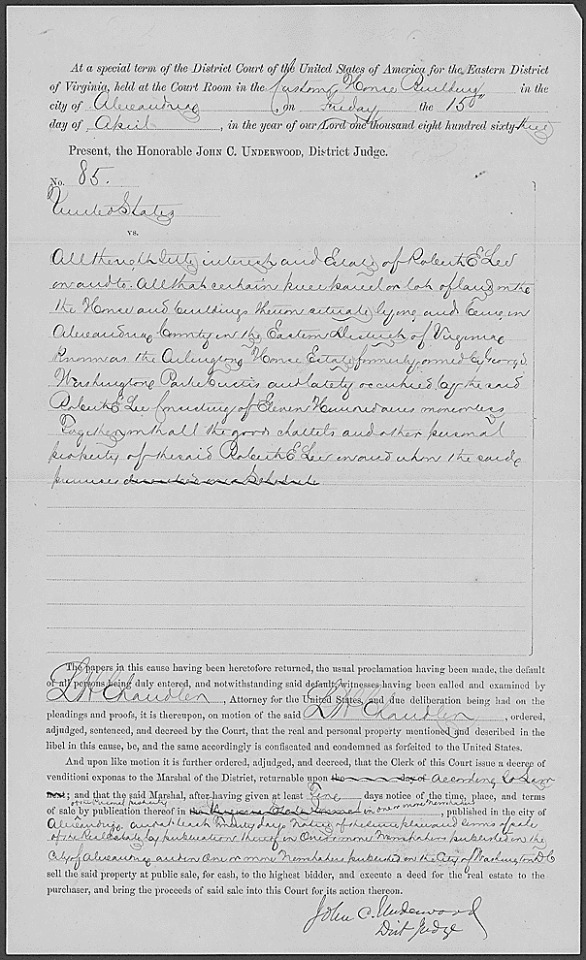
Condemnation Decree filed in U.S. v. All the Rights, Titles, of Robert E. Lee (Robert E. Lee Confiscation Case)
Record Group 21: Records of District Courts of the United StatesSeries: Confiscation Case FilesFile Unit: U.S. v. The Right, Title, Interest, and Estate of Robert E. Lee
[printed] At a special term of the District Court of the United States of America for the Eastern District of Virginia, held at the Court Room in the [handwritten] Customs House Building [typed] in the city of [handwritten] Alexandria [printed], on [handwritten] Friday the 15th day of April, [printed] in the year of our Lord one thousand eight hundred sixty three
[printed] Present, the Honorable John C. Underwood, District Judge.
[handwritten] No. 85
United States
vs.
All the rights titles interests and the Estate of Robert E Lee in and to All that certain piece parcel or lot of land and to the Home and buildings thereon situated lying and being in Alexandria County in the Eastern District of Virginia known as the Arlington House Estate formerly owned by George Washington Parke Custis and lately occupied by the said Robert E Lee Consisting of Eleven Hundred acres more or less Together with all the goods chattels and the personal property of the said Robert E Lee in and upon the said premises [illegible]
[printed] The papers in this cause having been heretofore returned, the usual proclamation having been made, the default of all persons being duly entered, and notwithstanding said default, witnesses having been called and examined by [handwritten] L H Chandler [printed] , Attorney for the United States, and due deliberation being had on the pleadings and proofs, it is thereupon, on motion of the said [handwritten] L H Chandler [printed] , ordered, adjudged, sentenced, and decreed by the Court, that the real and personal property mentioned and described in the libel in this cause, be, and the same accordingly is confiscated and condemned as forfeited to the United States.
[printed] And upon like motion it is further ordered, adjudged, and decreed, that the Clerk of this Court issue a decree of venditioni exponas to the Marshall of the District, returnable upon [handwritten] ascending [illegible word]; [typed] and that the said Marshal, after having given at least [handwritten- Tene?] [printed] days notice of the time, place, and terms of sale [carrot-handwritten in] of the personal property [printed] by publication thereof in [handwritten] the Virginia State District in one or more [illegible word] [printed] published in the city of [handwritten] Alexandriae. [illegible 3 words] dat. Notice of [illegible word] place and [illegible word] of sale of the Real Estate by [persecutions?] thereof in one or more [illegible 2 words] in the City of Alexandria and in one or more [illegible 2 words] in the City of Washington DC [printed] sell the said property at public sale, for cash, to the highest bidder, and execute a deed for the real estate to the purchaser, and bring the proceeds of said sale into this Court for its action thereon.
[handwritten signature] John C. Underwood
Dist Judge
36 notes
·
View notes
Text
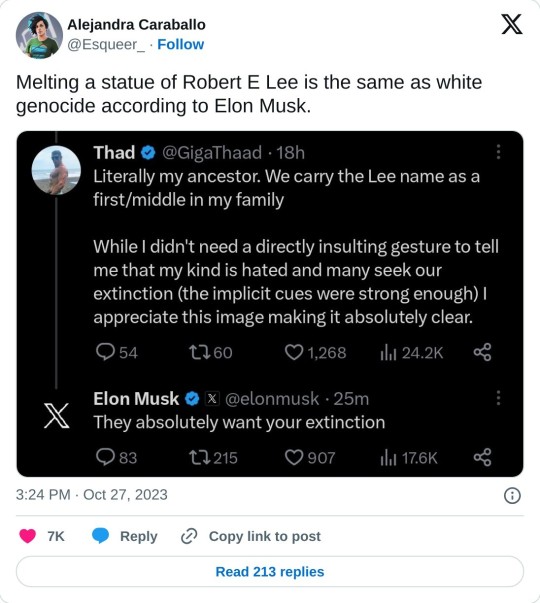
#us politics#republicans#conservatives#tweet#twitter#x#@esqueer_#alejandra caraballo#robert e. lee#confederate states of america#fuck the confederates#confederate pride#fuck the confederacy#confederate monuments#elon musk#fuck billionaires#eat the rich#2023
73 notes
·
View notes
Photo
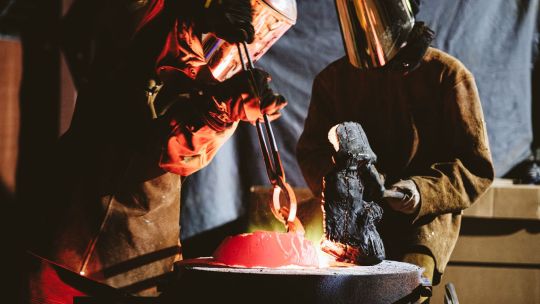
(via Robert E. Lee Confederate statue in Charlottesville melted down)
A community initiative dubbed "Swords into Plowshares" plans to use the materials to create a new work of public art it intends to gift to the city.
46 notes
·
View notes
Text
#OTD in 1861 – The American Civil War began; 150,000 Irishmen would serve with the Union forces, and 40,000 with the Confederacy.
The American Civil War began, a war that would not only pit American against American but also Irish against Irish. An estimated 150,000 Irish fought on the Union side while about 40,000 fought for the confederacy. While the majority fought with the Union, many Irish had a strong antipathy to a northern culture which they perceived as anti-Catholic and Protestant dominated. The most famous Irish…

View On WordPress
#American Civil War#Confederacy#Fighting 69th#General Patrick Cleburne#Irish Brigade#Irish Soldiers#Robert E. Lee#Thomas Meagher#Union
11 notes
·
View notes
Text
"Confederate monuments bear what the anthropological theorist Michael Taussig would call a public secret: something that is privately known but collectively denied. It does no good to simply reveal the secret — in this case, to tell people that most of the Confederate monuments were erected not at the end of the Civil War, to honor those who fought, but at the height of Jim Crow, to entrench a system of racial hierarchy. That’s already part of their appeal. Dr. Taussig has argued that public secrets don’t lose their power unless they are transformed in a manner that does justice to the scale of the secret. He compares the process to desecration. How can you expect people to stop believing in their gods without providing some other way of making sense of this world and our future?
Swords Into Plowshares might have been the first to propose melting, but other communities are working out their own creative visions for Lee’s afterlife. One of the biggest changes so far has been at Arlington House, the historic plantation mansion at the center of Arlington National Cemetery, which is the official national Robert E. Lee Memorial. In 2021, Arlington House reopened with displays not only about Lee’s family, who lived there after they inherited it from Lee’s father-in-law, but also about the lives of the families enslaved there. Even Lee’s burial site at Washington and Lee University in Lexington, Va. — where he served as president after the war — has changed. The university decided to focus on Lee the civilian rather than Lee the general, for example by moving a prominent portrait of him in uniform. And it constructed a wall to enclose the large sculpture of Lee that once claimed an insistent place in the university’s chapel.
Covering this story over the past few years, I’ve come to realize two things. First, when a monument disappears without a ceremony to mark why it is coming down, a community has no chance to recognize that it has itself changed. (Ideally the ceremony is public, but because of safety concerns, the melting I attended was not.) Second, if you are outraged that something’s happening to your community’s heroic statue of Lee, you’re not going to be any less outraged if the statue is moved to some hidden storeroom than if it’s thrown into a landfill. So if all changes, large or small, will be resisted, why not go for the ones with the most symbolic resonance?
That’s why the idea to melt Lee down, as violent as it might initially seem, struck me as so apt. Confederate monuments went up with rich, emotional ceremonies that created historical memory and solidified group identity. The way we remove them should be just as emotional, striking and memorable. Instead of quietly tucking statues away, we can use monuments one final time to bind ourselves together into new communities.
...
When the remaining legal barriers were cleared (including a last-minute lawsuit that sought to have the statue reassembled), Lee was finally ready to surrender to the furnace. The foundryman turned on the propane supply and laid Lee’s sword across the hole in the lid. He told the spectators that the metal had to get hot enough to release any moisture before he maneuvered it down through the hole into the crucible.
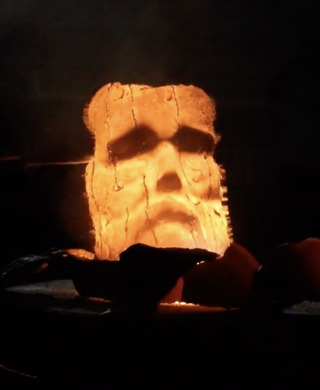
When he did, its blade stuck up out of the furnace for a moment, then melted down “like a stick of butter,” as Dr. Schmidt put it.
Lee’s face was the last piece to go into the crucible. Given how often the monument and its ideals were celebrated with flames — from Klansmen’s torches to the tiki torches of white nationalists in 2017 — it seemed fitting for flames to close over the monument.
...
Dr. Douglas, Swords Into Plowshares’ other co-founder, apologized that the ceremony could not be public. She thanked those in attendance, telling us we were witnessing it on behalf of Charlottesville’s residents, including those long gone who lived under slavery. Someday, she said, when we think of Civil War heroes, we will imagine not Lee but, instead, those who fought for their freedom against him.
The man in the protective visor dropped the red-hot piece of metal that once represented Lee on the ground. It fell to pieces, which he fed into the crucible. A line of cameras faced him, making new images of history as the old image finally disappeared in flames.
- Erin Thompson, "The Most Controversial Statue in America Surrenders to the Furnace." New York Times. October 24, 2023. Photo by Eze Amos.
#swords into plougshares#confederate monuments#robert e. lee#tear them down#historical monuments#american civil war#historical memory#united states history#united states politics
14 notes
·
View notes
Text
The strangest part about the continued personality cult of Robert E. Lee is how few of the qualities his admirers profess to see in him he actually possessed.
26 notes
·
View notes
Text

Explicitly has General Robert E. Lee consider how the AK-47 must have gone through many revisions and refinements to become the finished project, but doesn't have him declare "I say, I say, what about the other 46?" 0/10, would not recommend.
8 notes
·
View notes
Note
To follow the question about Jeff Davis, do you think Robert E Lee would be considered the greatest general in US history if not for being with the confederates in the civil war?
Don't you think that's a pretty big "if"?! Using a qualifier like that in your question is kind of like me asking people if they think my romantic relationship with Shakira would have been more successful if only she was aware of my existence.
59 notes
·
View notes
Text
Quick Thought – Friday, March 15, 2024: The Path to Success
Read
Matthew 25:14-30
His master said to him, “Well done, good and faithful servant. You have been faithful over a little; I will set you over much. Enter into the joy of your master.”
Matthew 25:23
Reflect
Not everyone starts out at the top. Some people work for years before they’re finally “discovered.” Consider the story of Sam.
Many years before the Civil War, Sam was a student at the U.S.…
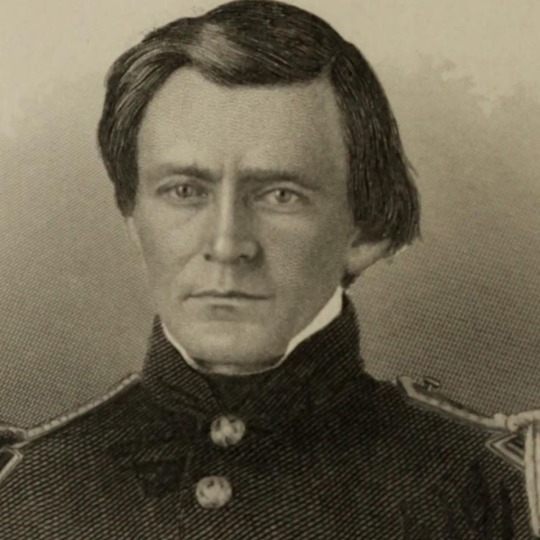
View On WordPress
#Army#Bible#bible study#Civil War#Confederacy#devotion#excellence#faith#General#God#Heaven#Jesus#Kingdom of God#military#military academy#President#Quick Thought#reflection#responsibility#Robert E. Lee#study#success#talent#Ulysses S. Grant#Union#United States#West Point
2 notes
·
View notes
Link
Please don't sleep on the Run Off. If you can donate, donate. If you live in Georgia, for fuckssake Vote! One more vote in the senate will definitely help. Also, no one with sense wants walker in the Senate for six years.
16 notes
·
View notes
Text

🎭
2 notes
·
View notes
Text
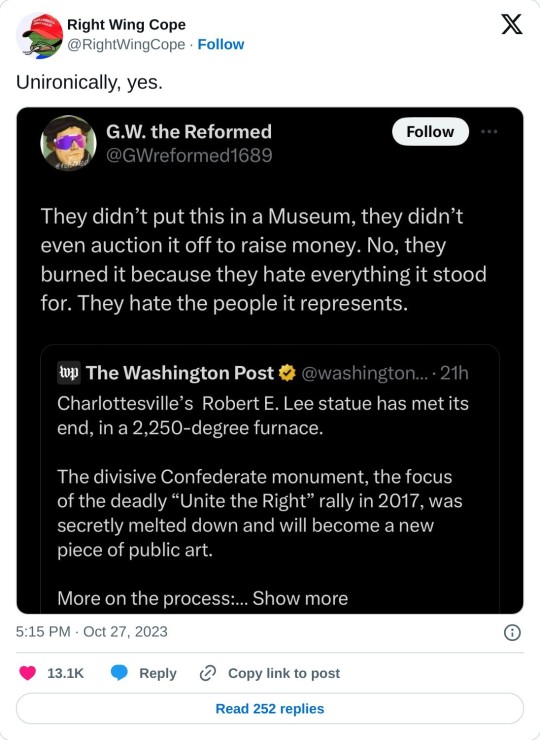
#us politics#tweet#twitter#x#@rightwingcope#republicans#conservatives#alt right#confederate states of america#confederate pride#fuck the confederacy#fuck the confederates#2023#robert e. lee#unite the right
63 notes
·
View notes
Text
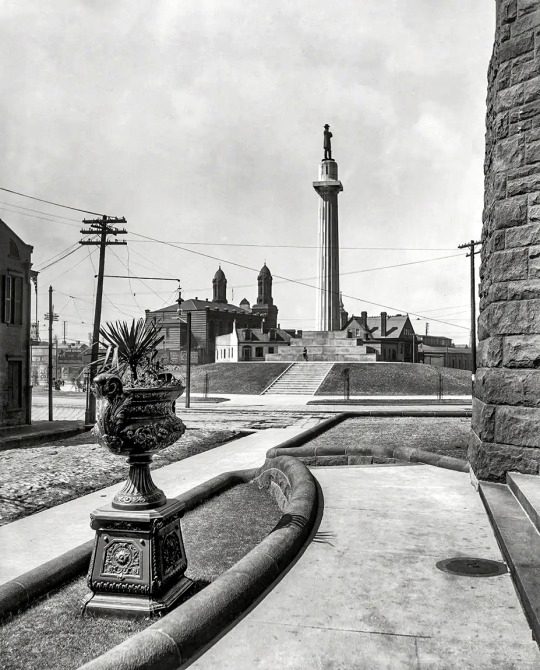
Scenes from home, past and present.
2 notes
·
View notes
Text
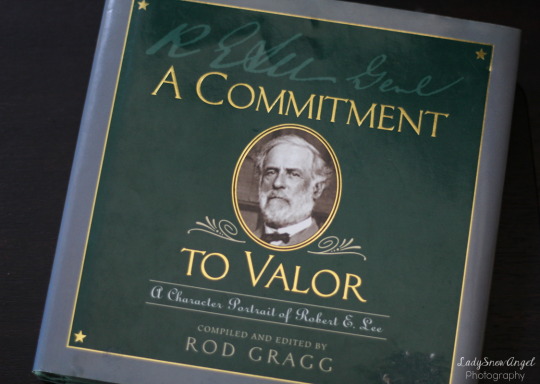
Currently reading A Commitment To Valor.
2 notes
·
View notes
Photo

Robert E. Lee and his horse Traveler
5 notes
·
View notes
Text
"GODS AND GENERALS" (2003) Review

"GODS AND GENERALS" (2003) Review
In 1993, producer Ted Turner and director Ronald Maxwell released "GETTYSBURG", a film adaptation of Michael Shaara's 1974 novel, "The Killer Angels". Shaara's son, Jeffrey, wrote a prequel to his novel called "Gods and Generals" in 1996. Both Turner and Maxwell teamed up again in 2002-2003 to make a film adaptation of the latter novel.
Set between April 1861 and May 1863, "GODS AND GENERALS" related the American Civil War events leading up to the Battle of Gettysburg. Although the movie began with Virginia-born Robert E. Lee's resignation from the U.S. Army, following his home state's secession from the Union; the meat of the film focused on the personal and professional life of Confederate general Thomas "Stonewall" Jackson during those two years. It also touched on how Bowdoin College professor Joshua L. Chamberlain became second-in-command of the 20th Maine Volunteer Infantry Regiment, his military training and his experiences during the Battle of Fredricksburg. But trust me . . . most of the movie is about Jackson. It covered his departure from the Virginia Military Institute; his experiences with the famous "Stonewall Brigade"; his experiences at the Battle of Bull Run; his relationships with both his wife Mary Anna, his servant Jim Lewis and a five-year-old girl from an old Virginia family; and his experiences at the Battle Chancelorville.
"GODS AND GENERALS" had its virtues. One of them turned out to be Michael Z. Hanan's production designs. Hanan and his team did a superb job in re-creating Virginia of the early 1860s. I was especially impressed by their recreation of mid-19th century Fredricksburg during that famous battle in December 1862. I wonder who had the bright idea of using Harper's Ferry, West Virgina for that particular setting. Hanan's work was ably supported by Kees Van Oostrum's photography and Gregory Bolton's art direction. Oostrum's photography and Corky Ehlers' editing was also put to good use during the Fredricksburg battle sequence. And I really enjoyed the costumes designed by Richard La Motte, Maurice Whitlock and Gamila Smith. All three did their homework in re-creating the fashions and uniforms of the period. Unlike "GETTYSBURG", "GODS AND GENERALS" featured major female characters. I suspect this gave the trio the opportunity to indulge their romantic streak with crinolines and hoop skirts galore.
There were some admirable performances in "GODS AND GENERALS". Frankie Faison gave a warm performance as Thomas Jackson's freedman cook, Jim Lewis. I was also impressed by Brian Mallon's subtle portrayal of the concerned Major General Winfield Hancock, a role he had first portrayed in the 1993 film. It is a pity that Bruce Boxleitner did not receive more screen time for his role as Lieutenant General James Longstreet. He had taken over the role from Tom Berenger and gave a pretty solid performance. But alas, he did not receive enough time to do anything with the role. Alex Hyde-White gave an interesting portrayal of Major General Ambrose Burnside, whose decisions led the Union Army to disaster at Fredricksburg. Matt Letscher was very memorable as the 20th Maine's founder and first regimental commander, Colonel Adelbert Ames. I could also say the same for Mira Sorvino's portrayal of Frances "Fanny" Chamberlain, Colonel Chamberlain's passionate and pessimistic wife. In fact, I believe she had the good luck to portray the most interesting female character in the movie.
So . . . what about the other performances? What about the stars Stephen Lang, Jeff Daniels and Robert Duvall? I am not claiming that they gave bad performances. Honestly, they did the best they could. Unfortunately, all three and most of the other cast members had the bad luck to be saddled with very uninteresting characterizations, bad dialogue and self-righteous speeches. In other words, I found them a little BORING!!! I am sorry, but I truly did.
First of all, Lang's Thomas Jackson dominated the film just a little too much. Why bother calling this movie "GODS AND GENERALS"? Why not call it "THE LIFE AND TIMES OF STONEWALL JACKSON"? Even worse, Jackson is portrayed in such an unrelenting positive light that by the time the movie came around to his fate after the Battle of Chancelorville, I practically sighed with relief. Jeff Daniels' Joshua Chamberlain did nothing to rouse my interest in his story. In fact, he disappeared for a long period of time before he made his reappearance during the Battle of Fredricksburg sequence. And his appearance in that particular sequence was completely marred by him and other members of the 20th Maine Volunteer Regiment quoting William Shakespeare's "JULIUS CAESAR", while marching toward Marye's Heights. Oh God, I hate that scene so much! As for Robert Duvall's Robert Lee . . . what a waste of his time. Ronald Maxwell's script did not allow the actor any opportunity to explore Lee's character during those two years leading to Gettysburg. I realize this is not Duvall's fault, but I found myself longing for Martin Sheen's portrayal of the Confederate general in "GETTYSBURG".
There is so much about this movie that I dislike. One, Maxwell's portrayal of the movie's two main African American characters - Jim Lewis and a Fredricksburg slave named Martha, as portrayed by actress/historian Donzaleigh Abernathy - struck me as completely lightweight. Now, I realized that there were black slaves and paid employees who managed to maintain a friendly or close relationship with their owner or employer. But in "GODS AND GENERALS", Lewis seemed quite friendly with his employer Jackson and Martha seemed obviously close to the family that owned her, the Beales. I could have tolerated if Lewis or Martha had been friendly toward those for whom they worked. But both of them? I get the feeling that Maxwell was determined to avoid any of the racial and class tensions between the slave/owner relationship . . . or in Lewis' case, the employee/employer relationship. How cowardly.
In fact, this lack of tension seemed to permeate all of the relationships featured in "GODS AND GENERALS". Aside from one Union commander who berated his men for looting in Fredricksburg, I can barely recall any scenes featuring some form of anger or tension between the major characters. Everyone either seemed to be on his or her best behavior. And could someone please explain why every other sentence that came out of the mouths of most characters seemed to be a damn speech? I realize that Maxwell was trying to re-create the semi-formality of 19th century American dialogue. Well . . . he failed. Miserably. The overindulgence of speeches reminded me of the dialogue from the second NORTH AND SOUTH miniseries, 1986's "NORTH AND SOUTH: BOOK II". But the biggest problem of "GODS AND GENERALS" was that it lacked a central theme. The majority of the movie seemed to be about the Civil War history of Thomas Jackson. But the title and Shaara's novel told a different story. However, I do not believe a detailed adaptation of the novel would have done the trick. Like the movie, it lacked a central theme or topic.
Perhaps I am being too arrogant in believing I know what would have made the story worked. After all, it is not my story. Jeff Shaara was entitled to write it the way he wanted. And Ronald Maxwell was entitled to adapt Shaara's story the way he wanted. But I do know that if I had written "GODS AND GENERALS", it would have been about the Battle of Fredricksburg. It turned out to be the only part of the movie that I found interesting.

#jeff shaara#gods and generals#gods and generals 2003#thomas stonewall jackson#stonewall jackson#stephen lang#joshua lawrence chamberlain#jeff daniels#robert e. lee#robert duvall#battle of bull run#battle of fredericksburg#battle of chancelorville#alex hyde-white#brian mallon#mira sorvino#kali rocha#matt letscher#bruce boxleitner#coooper huckabee#malachy mccourt#john castle#jeremy london#patrick gorman#bill campbell#royce d applegate#frankie faison#w. morgan sheppard#kevin conway#c. thomas howell
3 notes
·
View notes